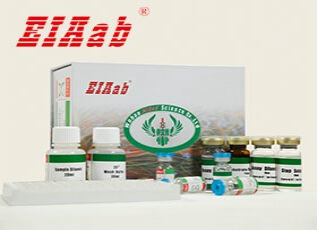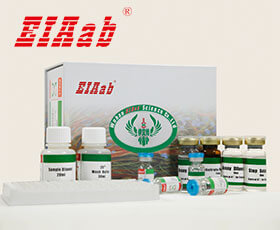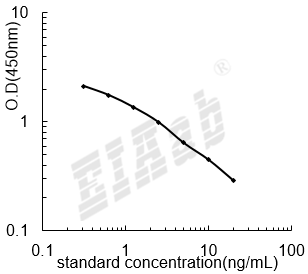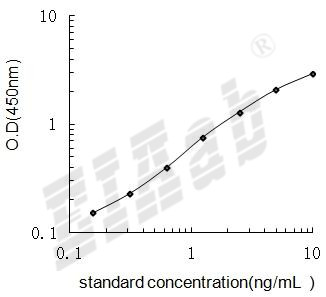Kcnk1 (基因名), Potassium channel subfamily K member 1 (蛋白名), kcnk1_rat.
产品名称:
Rat Kcnk1/ Potassium channel subfamily K member 1 ELISA Kit
货号:
-
商标:
EIAab®
监管等级:
别名:
Inward rectifying potassium channel protein TWIK-1, Potassium channel K2P1, rTWIK
检测方法:
ELISA
特异性:
Natural and recombinant rat Potassium channel subfamily K member 1
样品类型:
Serum, plasma, tissue homogenates, cell culture supernates and other biological fluids
样品数据:
登录.
研究领域:
-
通用注释
亚单元:
Homodimer; disulfide-linked (PubMed:9843722). Heterodimer with KCNK2; disulfide-linked (By similarity). In astrocytes, forms mostly heterodimeric potassium channels with KCNK2, with only a minor proportion of functional channels containing homodimeric KCNK1 (By similarity). Interacts with KCNK3 and KCNK9, forming functional heterodimeric channels (By similarity). Interacts with GNG4 (By similarity). Identified in a complex with PSD and ARF6; interacts only with PSD that is bound to ARF6 (By similarity). Interacts with UBE2I.
功能:
Ion channel that contributes to passive transmembrane potassium transport and to the regulation of the resting membrane potential in brain astrocytes, but also in kidney and in other tissues (PubMed:17452494, PubMed:19571146). Forms dimeric channels through which potassium ions pass in accordance with their electrochemical gradient. The channel is selective for K(+) ions at physiological potassium concentrations and at neutral pH, but becomes permeable to Na(+) at subphysiological K(+) levels and upon acidification of the extracellular medium (PubMed:22948150). The homodimer has very low potassium channel activity, when expressed in heterologous systems, and can function as weakly inward rectifying potassium channel. Channel activity is modulated by activation of serotonin receptors (PubMed:17452494). Heterodimeric channels containing KCNK1 and KCNK2 have much higher activity, and may represent the predominant form in astrocytes (By similarity). Heterodimeric channels containing KCNK1 and KCNK3 or KCNK9 have much higher activity. Heterodimeric channels formed by KCNK1 and KCNK9 may contribute to halothane-sensitive currents (By similarity). Mediates outward rectifying potassium currents in dentate gyrus granule cells and contributes to the regulation of their resting membrane potential (By similarity). Contributes to the regulation of action potential firing in dentate gyrus granule cells and down-regulates their intrinsic excitability (By similarity). Contributes to the regulation of the resting membrane potential of pancreatic beta cells (By similarity). In astrocytes, the heterodimer formed by KCNK1 and KCNK2 is required for rapid glutamate release in response to activation of G-protein coupled receptors, such as F2R and CNR1 (By similarity). Required for normal ion and water transport in the kidney (By similarity). The low channel activity of homodimeric KCNK1 may be due to sumoylation. The low channel activity may be due to rapid internalization from the cell membrane and retention in recycling endosomes.
亚细胞位置:
Cell membrane
Multi-pass membrane protein
Recycling endosome
Apical cell membrane
Multi-pass membrane protein
Cytoplasmic vesicle
Perikaryon
Cell projection
Dendrite
Cell projection
Cell junction
Synapse
The heterodimer with KCNK2 is detected at the astrocyte cell membrane. Not detected at the astrocyte cell membrane when KCNK2 is absent. Detected on neuronal cell bodies, and to a lesser degree on neuronal cell projections (By similarity). Detected in synaptic membranes (PubMed:9843722). Detected at the apical cell membrane in stria vascularis in the cochlea (PubMed:12855359). Detected on hippocampus dentate gyrus granule cell bodies and to a lesser degree on proximal dendrites. Detected at the apical cell membrane of vestibular dark cells situated between the crista and the utricle in the inner ear. Detected at the apical cell membrane in kidney proximal tubule segment S1 and in subapical compartments in segments S1, S2 and S3 (PubMed:9843722). Predominantly in cytoplasmic structures in kidney distal convoluted tubules and collecting ducts (By similarity). Detected at the apical cell membrane of bronchial epithelial cells (By similarity).
数据库链接
您可能感兴趣
该产品尚未在任何出版物中被引用。
[1].
大鼠Kcnk1ELISA试剂盒可以做多少个样本?
大鼠Kcnk1ELISA试剂盒分为2种规格,96孔和48孔。96孔的试剂盒,标曲和样本都做复孔的话,可以检测40个样本。96孔的试剂盒,标曲和样本都不做复孔的话,可以检测88个样本。
[2].
大鼠Kcnk1ELISA试剂盒使用视频?
大鼠Kcnk1ELISA试剂盒实验操作视频在以下网址中,对每一步的实验步骤都做了演示,方便实验员能更好地理解ELISA实验的过程。
https://www.eiaab.com.cn/lesson-tech/805.html
https://www.eiaab.com.cn/lesson-tech/805.html
[3].
大鼠Kcnk1ELISA试剂盒是放在-20℃冰箱保存吗?
EIAab的大鼠Kcnk1ELISA试剂盒,洗涤液、底物、终止液保存于4℃,其余试剂-20℃冰箱保存。
[4].
大鼠Kcnk1ELISA试剂盒原理?
双抗体夹心法:用纯化的抗体包被微孔板,制成固相抗体,往包被有固相抗体的微孔中依次加入标准品或受检样本、生物素化抗体、HRP标记的亲和素,经过彻底洗涤后用底物TMB显色。用酶标仪在450nm波长下测定吸光度(OD值),计算样本浓度。
竞争法:用纯化的抗体包被微孔板,制成固相抗体,往包被有固相抗体的微孔中依次加入标准品或受检样本和生物素标记的目标分析物,受检标本中抗原与生物素标记抗原竞争结合有限的抗体。再加入HRP标记的亲和素,经过彻底洗涤后用底物TMB显色。用酶标仪在450nm波长下测定吸光度(OD值),计算样本浓度。
竞争法:用纯化的抗体包被微孔板,制成固相抗体,往包被有固相抗体的微孔中依次加入标准品或受检样本和生物素标记的目标分析物,受检标本中抗原与生物素标记抗原竞争结合有限的抗体。再加入HRP标记的亲和素,经过彻底洗涤后用底物TMB显色。用酶标仪在450nm波长下测定吸光度(OD值),计算样本浓度。
[5].
大鼠Kcnk1ELISA试剂盒中需要使用的样品量是多少?
夹心法100μL/孔,竞争法50μL/孔。如样本浓度过高时,应对样本进行稀释,以使稀释后的样本符合试剂盒的检测范围,计算时再乘以相应的稀释倍数。
[6].
如何分析大鼠Kcnk1ELISA试剂盒数据?
建议标准曲线,并计算样本浓度。对于elisa的曲线拟合,一般建议采用4参数曲线拟合,4参数曲线拟合通常更适合免疫分析。推荐使用专业软件进行曲线拟合,例如curve expert 1.3。根据样本的OD值由标曲查出相应的浓度,再乘以稀释倍数;或用标准物的浓度与OD值计算出标曲的回归方程式,将样本的OD值代入方程式,计算出样本浓度,再乘以稀释倍数,即为样本的实际浓度。以下链接是curve expert 1.3软件拟合曲线的方法。
https://www.eiaab.com.cn/news/502/
https://www.eiaab.com.cn/news/502/
[7].
大鼠Kcnk1ELISA试剂盒中是否包含人和动物的副产物,是否包含感染的或者传染性原料如HIV等?
除了抗体和稀释液中的BSA,不含其它人和动物的副产物,也不含感染材料。
[8].
收集大鼠Kcnk1ELISA试剂盒血浆样本,用什么作为抗凝剂?
一般建议用EDTA和肝素作为抗凝剂。
[9].
大鼠Kcnk1ELISA试剂盒酶标板可以拆成几部分?拆的时候是否需要避光,无菌?
大鼠Kcnk1ELISA试剂盒酶标板是8×12孔条,可拆卸,板子可以拆成12条,注意避免孔污染,不需要避光和无菌。暂时不用的板子,放回原来装的袋子里,密封保存。
[10].
大鼠Kcnk1ELISA试剂盒样本如何保存?
尽量检测新鲜样本。若无新鲜样本,则4℃保存1周,-20℃保存1个月,-80℃保存2个月。
反馈墙
评论数 : 0
所有用户
所有用户
默认排序
默认排序
最近
早期
目前还没有评论。






通知
规格
数量
单价 (¥)
小计 1 (¥)
小计 2:
¥

规格
数量
单价 (¥)





 验证序列:
验证序列:




 折扣:
折扣: